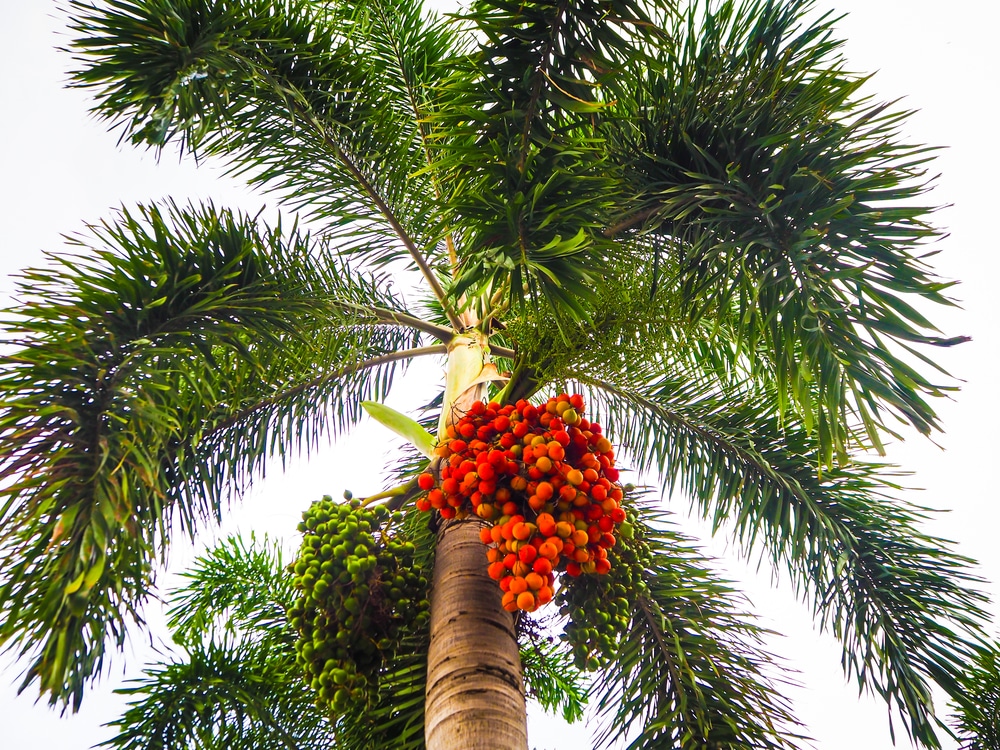The Foxtail Palm is an Australian native exceptionally famous for its adaptability and fast-growing habits. In addition, it is amazing for its perfect proportions making it an excellent stand-alone specimen and is also great for screening.
It has fronds that are round in shape and resembles the tail of the fox, hence its name. This palm is one of the most popular species that is widely sought after. It has a remarkably smooth trunk, and its uniqueness makes it easy to identify. It is commonly used for lining driveways or as an ornamental palm in public places and resorts.
| Botanical Name | Wodyetia Bifurcata |
| Common Name | Foxtail Palm |
| Plant Type | Perennial |
| Flower Color | White flowers that are borne in great clusters |
| Size When Mature | 240 inches |
| Bloom Time | Early Spring |
| Sun Requirements | Full Sun |
| USDA Hardiness Zones | 10 – 11 |
| Soil PH Range | 5.6 – 7.8 |
| Soil Type | Slightly acidic, well-draining |
| Water Needs | Medium to High |
| Native Area | Australia |
What You Need to Know About Foxtail Palm
This tree has feathery foliage that is a variation of green colors. It has fronds with delicately arched leaves, with each frond having approximately about 40 leaflets. A fully grown tree can have fronds about the length of 120 inches. Its leaves are plumose because they resemble a plume with a bushy-like appearance.
Spent leaves will die and eventually drop from the tree as needed to enable new growth. In the early spring, a stalk from the base of the crown shaft would appear with blooming white flowers.
It would then produce orange-red fruits. Among all the palm species, Foxtail Palm is the only one known to be poisonous, so it would be best to keep your pets and small children away from this tree.
It is a fast-growing tree, and if you want to keep its growth under control, you need to provide enough space for it to grow freely. Additionally, the Foxtail Palm is an easy tree to take care of, especially since it is a self-cleaning specimen. However, bear in mind that pruning may be necessary from time to time to get rid of the dead leaves, maintain their shape, or control their growth.
How to Care for Foxtail Palm
Here’s everything you need to know about growing and caring for a thriving Foxtail Palm:
Light
The foxtail palm tree thrives in full sun, although it may also grow in partially shaded areas. Because foxtail palms prefer bright light, they may be challenging to grow indoors unless you have a conservatory or a greenhouse. However, they may grow to be beautiful houseplants if provided with enough light to survive.
Indoors, place your foxtail palm tree in a sunny spot near a south or west-facing window. If you cannot provide enough light for your palm, it will likely become leggy, and its fronds will yellow.
Water and Soil Needs
Foxtail palms are not picky when it comes to soils, but they do prefer well-draining ones. It grows best in slightly acidic soil having pH levels of 5.6 to 7.8. It grows in a wide range of soil types, including alkaline limestone soils and rocky sands, making it an adaptable plant. They are drought-tolerant and can withstand extended periods without water. However, they will appreciate a good soaking during dry spells.
Temperature Requirements
Mature foxtail palms can withstand light frosts and short bursts of temperatures as low as 27 degrees Fahrenheit without suffering significant damage. However, if the temperature drops below freezing for extended periods of time or if it freezes, the leaves will become discolored and sometimes die off. It can survive in USDA zones 10-11.
Fertilizer
The best fertilizer to use on a Foxtail Palm is a slow-release fertilizer that is made explicitly for palms. These palms can be heavy feeders, so you may fertilize your plant 4 times a year, ideally during the months of February, May, October, and December.
Common Diseases
While Foxtail palms are resistant to diseases and pests, they are still vulnerable. Rhinoceros beetles, for example, create holes in your palm tree trunks and consume the insides. The red palm weevil is another pest that may deposit eggs in the holes created by rhinoceros beetles. Palm leaf skeletonizers, aphids, mealybugs, spider mites, and scale insects are all pests that you’ll have to deal with when it comes to your Foxtail Palm. You won’t be able to undo the damage, but you can easily get rid of them by using insecticides and pesticides.
Crown rot and root rot are usually caused by poor drainage or overwatering. In order to prevent these, you need to make sure that your palm tree is getting just the right amount of water. Leaf spot diseases are also common problems you may encounter. These can usually be treated with fungicides.
Foxtail Palm Propagation
Because other means aren’t as effective, propagation is more commonly done by using freshly collected seeds and then planting them immediately. Other methods like air-layering, cuttings, and division may be used, but they aren’t as effective as seed propagation.
To plant the seeds, fill a pot that has drainage holes with a well-draining potting mix. Sow the seeds about ½ an inch deep in the mix and water them gently.
These seeds usually take about three to six months to germinate, and you’ll know they’re ready to be transplanted when they have at least two sets of fronds.


